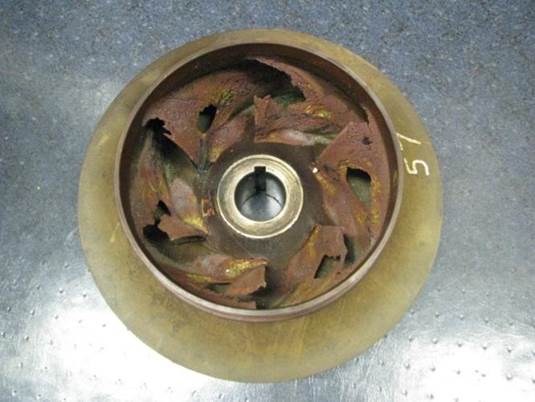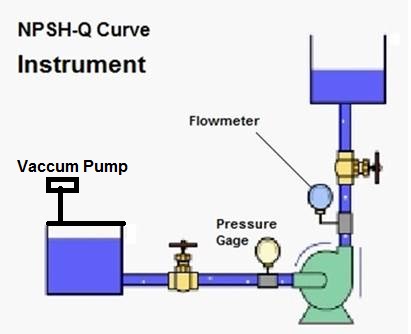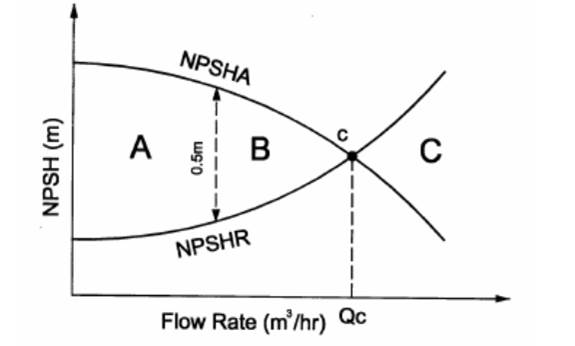Pump Net Positive Suction Head Test (NPSH Test)
The centrifugal pump net positive suction head test (NPSH Test) is conducted after completion of the performance test. We perform the NPSH test to measure the ability of the pump to avoid cavitation in the inlet section of the pump.
Let's get started with an example. You are witnessing an NPSH test at the manufacturing shop. The pump approved datasheet indicates the following information:
NPSHA = 11.09 m (36.38 feet)
Rated Flow = 238.5 m³/h (1050.08 Gal/Min)
The NPSHA stands for "net positive suction head available." Pump purchaser provides the NPSHA to the pump manufacturer for design purposes.
The measured/ calculated value in the NPSH test is named NPSHR (net positive suction head required).
So you have to delineate these two terms as below:
NPSHA comes from pump purchaser (customer)
NPSHR provided by pump manufacturer, and it is actual measured value
The NPSH Test result will be satisfactory if the NPSHR is less than NPSHA.
Look at the following curve and determine the result of NPSH test?

Locate NPSH curve, the NPSH @ 238.5 m³/h is 8 m which is less than 11.09. So the result of the test is OK.
This is the way you determine the pump net positive suction head test result and now let be a little bit more in-depth on the subject:
Cavitation and Pump Net Positive Suction Head Test
The following curve illustrates that cavitation is not happening on the curve (a) because suction pressure is higher than vapor pressure. Contrary, the curve (b) illustrates a cavitation problem because the suction pressure is less than vapor pressure. The suction section is the Achilles heel of the centrifugal pump.

The cavitation is the vaporizing of pumped fluid and bursting on pump impellers, and this process happens at the 0.01 second and is very unstable.

Saturation temperature means boiling point. The saturation temperature is the temperature for a corresponding saturation pressure at which a liquid boils into its vapor phase.
The saturation temperature is affected by pressure for instance water boils at 100º C or 212º F at sea level that can be considered 1 bar or 14.7 psi. Now if you increase the pressure the water will boil higher than 100º C or 212º F.
Contrary if you reduce the pressure the water will boil less than 100º C or 212º F. This is what happening in the impeller eye, an area exists with negative pressure (vacuum) and creates a low-pressure system in the impeller eye. So, water changes to vapor phase and water bubble forms and cause cavitation.
The cavitation causes the reduction in efficiency and increase of noise and vibration. The bursting of bubbles can produce a localized pressure up to 〖10〗^5 PSI that is very detrimental.

NPSHA; NPSH (Net Positive Suction Head) determined by the purchaser for the pumping system with the liquid at the rated flow and normal pumping temperature.
NPSHR; Net Positive Suction Head Required (NPSHR or NPSH3) NPSH that results in a 3 % loss of head (first-stage head in a multistage pump) determined by the vendor by testing with water.
Pump Net Positive Suction Head Test Process
The suction pressure is reduced in a series of steps (by vacuum pump or throttling valve). For each step, the pump outlet valve is adjusted to keep the flowrate (q) at a constant value.
The final reading is taken at the point where the pump head has decreased by at least 3 percent. This shows that a detrimental level of cavitation is occurring and defines the attained NPSHR value. To be acceptable, this reading must be less than NPSHA.

It means we gradually reduce the suction pressure until we achieve 3% reduction on the head, then we stop the test and record NPSHR.
Then we start the pump net positive suction head test with another flowrate and attain the NPSHR for the second flowrate. So if you have 5 test points, you have to repeat the test 5 times. One test per each flowrate. Then you can draw the Q-NPSH curve.
In other words, the NPSHR is vapor pressure in the impeller eye and NPSHA is the suction pressure, suction pressure always should be higher than vapor pressure to avoid cavitation.

If the pump operates in the A region, your pump is operating on the safe condition regarding cavitation. If it operates on the B, you are on the discreet region because your NPSHA still is higher than NPSHR but if for any reason your NPSHA being decreased by choking or pettiness on connecting suction pipe, your pump might experience cavitation.
The pump in the C area completely works on the cavitation region and cavitation will happen definitely.
Free newsletter!
Sign up to receive my monthly newsletter covering all the latest courses and updates.




New! Comments
Have your say about what you just read! Leave me a comment in the box below.